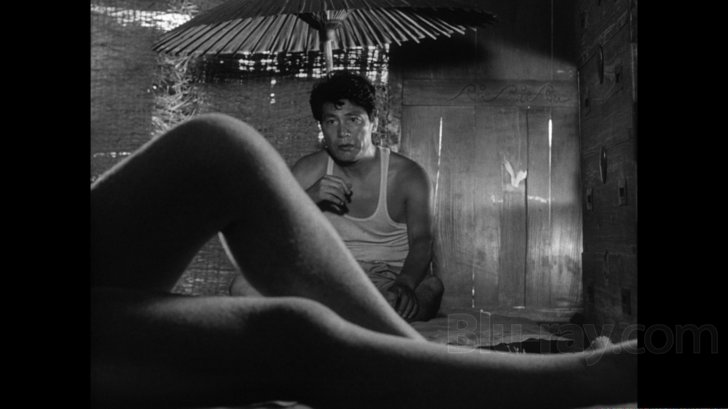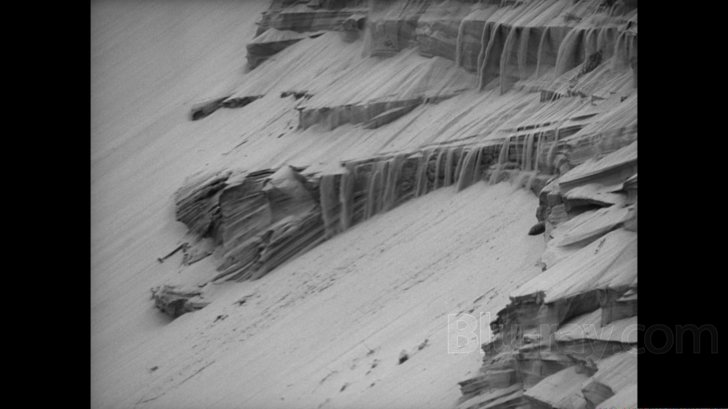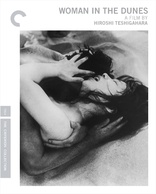Woman in the Dunes Blu-ray Movie
HomeWoman in the Dunes Blu-ray Movie 
砂の女 / Suna no onnaCriterion | 1964 | 147 min | Not rated | Aug 23, 2016
Movie rating
8.3 | / 10 |
Blu-ray rating
| Users | 0.0 | |
| Reviewer | 4.5 | |
| Overall | 4.5 |
Overview
Woman in the Dunes (1964)
An amateur entomologist leaves Tokyo to study an unclassified species of beetle found in a vast desert. When he misses his bus back to civilization, he is persuaded to spend the night with a young widow in her hut at the bottom of a sand dune.
Starring: Eiji Okada, Kyôko Kishida, Kôji Mitsui, Sen Yano, Ginzô SekiguchiDirector: Hiroshi Teshigahara
| Foreign | 100% |
| Drama | 75% |
| Thriller | Insignificant |
Specifications
Video
Video codec: MPEG-4 AVC
Video resolution: 1080p
Aspect ratio: 1.34:1
Original aspect ratio: 1.37:1
Audio
Japanese: LPCM Mono (48kHz, 24-bit)
Subtitles
English
Discs
50GB Blu-ray Disc
Single disc (1 BD)
Playback
Region A (locked)
Review
Rating summary
| Movie | 4.5 | |
| Video | 4.5 | |
| Audio | 5.0 | |
| Extras | 4.0 | |
| Overall | 4.5 |
Woman in the Dunes Blu-ray Movie Review
Reviewed by Dr. Svet Atanasov August 28, 2016Nominated for Oscar Award for Best Director, Hiroshi Teshigahara's "Woman in the Dunes" (1964) arrives on Blu-ray courtesy of Criterion. The supplemental features on the disc include an original trailer for the film; four short films directed by Hiroshi Reshigahara; archival video essay by James Quandt; and more. The release also arrives with a 30-page illustrated booklet featuring Audie Bock's essay "Shifting Sands", "Interview with Hiroshi Teshigahara" by Max Tessier, and technical credits. Region-A "locked".

The entomologist
It is most likely safe to assume that David Lynch has seen Hiroshi Teshigahara’s Woman in the Dunes. Like a lot of Lynch’s films, Woman in the Dunes builds a very special atmosphere and then connects with the viewer in a particular way. It tells an interesting story, but again like a lot of Lynch’s films it leaves a lasting impression because it delivers a fascinating message that can inspire some very interesting discussions.
The film begins in a beautiful desert area somewhere in rural Japan. The young entomologist Niki Jumpei (Eiji Okada, Hiroshima mon amour) has come here looking for exotic insects that he plans to study and add to his collection. He spends the entire day ‘hunting’ and when eventually misses the last bus heads to a nearby village. A few local men lead him to a strange house hidden in a pit amidst the dunes where he can spend the night. To actually get to the house he must use a long rope, which is then quietly removed.
A kind young woman (Kyoko Kishida, The Face of Another) greets Niki and offers him a hot meal. During the course of the night, she also reveals to him that she has recently lost her husband and child in a terrible sandstorm. She has chosen to stay, but taking care of the house has been difficult. Each night the woman must spend long hours shoveling the sand around the house so that it does not collapse. The sand from the pit is also what she uses to make ends meet. Because it has more salt than the one outside the pit, she gives it to the men from the village in exchange for water and food supplies. The sand then ends up on the black market where it is sold to construction companies from the city.
On the following day Niki makes a distributing discovery – the rope he used to get to the bottom of the pit is now missing and there is no way for him to get out. As time slowly passes by, he also begins to realize that his host has a special plan for him.
Teshigahara’s film is more than fifty years old but it feels strikingly relevant today. Indeed, it offers two contrasting but quite common views of life as an ongoing cycle of mostly meaningless triumphs and failures. The entomologist represents the supposedly more rational and better educated segment of society that has embraced the contemporary way of life. There is a ‘logical’ structure and rhythm in it and until the moment he realizes that he is trapped in the pit he does not question the way things are; he is comfortable and perhaps even ‘happy’ with the events that define his existence. Then, while feeling helpless, he suddenly begins to understand how flawed and dangerously brittle they truly are. (The current version of the contemporary way of life is strikingly similar. For example, folks from the group that is represented by the entomologist are basically trained to feel satisfied or happy if their lives have a very particular ‘logical’ structure and rhythm. They need a proper job, steady income, and a plan that gradually leads them to their final destination: the comfortable retirement). The woman represents the poorer and uneducated segment of society. Her life has been harsher but she also does not question its structure and rhythm. She has accepted them as her fate and feels satisfied when her work at the end of the night is done. (There is a very large group of people nowadays that exist in a similar way. They are basically trapped in an odd cycle trying to save a sinking home while white-collar crooks are benefiting from their misery).
The message that emerges at the end is that life is perhaps too cynical and ultimately completely pointless. Excluding the occasional feelings and emotions that bring some temporary flavor to it, it is basically a one-dimensional struggle to remain biologically active for as long as possible.
Woman in the Dunes Blu-ray Movie, Video Quality 

Presented in an aspect ratio of 1.34:1, encoded with MPEG-4 AVC and granted a 1080p transfer, Hiroshi Teshigahara's Woman in the Dunes arrives on Blu-ray courtesy of Criterion.
The following text appears inside the booklet provided with this Blu-ray release:
"This high-definition digital transfer was created on a Spirit DataCine from 35mm composite fine-grain master positive. Thousands of instances of dirt, debris, scratches, splices, and warps were manually removed using MTI Film's DRS and the Pixel Farm's PFClean, while Digital Vision's Phoenix was used for jitter, flicker, small dirt, grain, and noise management. The original monaural soundtrack was remastered from an optical fine-grain print. Clicks, thumps, hiss, hum, and crackle were manually removed using Pro Tools HD and iZotope RX4.
Transfer supervisor: Maria Palazzola.
Colorist: Gregg Garvin/Modern VideoFilm, Los Angeles."
The technical presentation is extremely similar to that of Kaneto Shindo's The Naked Island, and this is certainly very good news. Viewers who have previously seen the DVD release of Woman in the Dunes should immediately notice the improved depth during the darker footage. Indeed, a lot of the background visuals are now substantially better defined; the improved shadow definition brings out a wider range of nuances as well. During extreme close-ups depth is again more convincing, making it easier to see fine details that are unrecognizable on the DVD release. There is plenty of footage where fluidity is dramatically improved; on the DVD release during the same footage there are actually plenty of smeary/blocky patches. Grain is very well exposed and defined. There are no traces of problematic sharpening adjustments. Image stability is excellent. Lastly, it shows that specific work was done to eliminate age-related imperfections because the entire film looks strikingly healthy. My score is 4.75/5.00. (Note: This is a Region-A "locked" Blu-ray release. Therefore, you must have a native Region-A or Region-Free player in order to access its content).
Woman in the Dunes Blu-ray Movie, Audio Quality 

There is only one standard audio track on this Blu-ray release: Japanese LPCM 1.0. Optional English subtitles are provided for the main feature.
The lossless audio has very good depth and excellent range of nuanced dynamics. This isn't to imply that the overall dynamic intensity can rival the type of dynamic movement contemporary films typically have, but all of the effects and unique noises and sounds (the wind, the falling sand, dogs barking, and especially the recorded atonal sounds) are wonderfully reproduced. The dialog is clean and well balanced, but a few fluctuations that are part of the original sound design remain. There are no pops, audio dropouts, or digital distortions to report.
Woman in the Dunes Blu-ray Movie, Special Features and Extras 

- Trailer - original trailer for Woman in the Dunes. In Japanese, with optional English subtitles. (3 min, 1080p).
- Video Essay - in this archival video essay, James Quandt of the Cinematheque Ontario (now TIFF Cinematheque) discusses the major themes in Woman in the Dunes, some different interpretations of its message, its visual style, and reception and reputation. The essay was created exclusively for Criterion in 2007. In English, not subtitled. (30 min, 1080i).
- Teshigahara and Abe - this archival documentary film takes a closer look at the professional relationship between director Hiroshi Teshigahara and writer Kobo Abe and the state of the Japanese film industry during the 1960s. Included in it are clips from various archival interviews with film programmer and professor Richard Pena, film scholar Tadao Sato, film scholar Donald Richie, screenwriter John Nathan, set designer Arata Isozaki, and producer Noriko Nomura. The interviews were conducted exclusively for Criterion in 2006. In English and Japanese, with optional English subtitles where necessary. (35 min, 1080i).
1. New modernist cinema
2. Sofu Teshigahara
3. Sogetsu rumpus room
4. Unique collaboration
5. Existentialist leanings
6. Tradition and discovery
- Shorts - presented here are four short films directed by Hiroshi Teshigahara.
1. Hokusai (1953) -- Hiroshi Teshigahara's fist short film about the life and legacy of wood-block artist Katsushika Hokusai (1760-1849). B/W. In Japanese, with optional English subtitles. (23 min, 1080p).
2. Ikebana (1956) - this short film promotes the work the Sogetsu School of Ikebana and its founder and grand master, Sofu Teshigahara (father of the director). Color. In Japanese, with optional English subtitles. (33 min, 1080p).
3. Tokyo 1958 (1958) - during the same year this documentary was made, Tokyo was the largest city in the world. Hiroshi Teshigahara and eight other filmmakers attempted to capture its rhythm and atmosphere on film. Color. In Japanese, English, and French, with optional English subtitles where necessary. (24 min, 1080p).
4. Ako (1965) - this short film, also known as White Morning, about a 16-year-old Japanese girl and her friends was part of the omnibus La fleur de l'age, ou Les adolescentes, which was commissioned by the National Film Board of Canada. In Japanese, with optional English subtitles. (29 min, 1080p).
- Booklet - 30-page illustrated booklet featuring Audie Bock's essay "Shifting Sands", "Interview with Hiroshi Teshigahara" by Max Tessier, and technical credits.
Woman in the Dunes Blu-ray Movie, Overall Score and Recommendation 

Hiroshi Teshigahara's Woman in the Dunes offers a pretty cynical but quite accurate summation of what life truly is. There are some details that can be interpreted in different ways, but I find them largely irrelevant. Criterion's new Blu-ray release is sourced from a very solid organic master that makes it easy to experience the film in an entirely new way. (Tôru Takemitsu's minimalistic atonal score is also more effective on it). Also included on the Blu-ray are four short films from Hiroshi Teshigahara, plus some nice archival bonus features. HIGHLY RECOMMENDED.
Similar titles
Similar titles you might also like

Persona
1966

Monos
2019

Pioneer
Pionér
2013

Ikiru
生きる
1952

Through a Glass Darkly
Såsom i en spegel
1961

Yi Yi
一一
2000

The Silence
Tystnaden
1963

Beau Travail
1999

A Hijacking
Kapringen
2012

Wake in Fright
1971

Late Spring
晩春
1949

The Passion of Anna
En passion
1969

The Magician
Ansiktet
1958

Port of Call
Hamnstad
1948

The Rite
Riten / The Ritual
1969

An Autumn Afternoon
秋刀魚の味
1962

Tokyo Story
東京物語
1953

High and Low
Tengoku to jigoku / 天国と地獄
1963

Graduation
Bacalaureat
2016

Sansho the Bailiff
山椒大夫 / Sanshô dayû
1954
